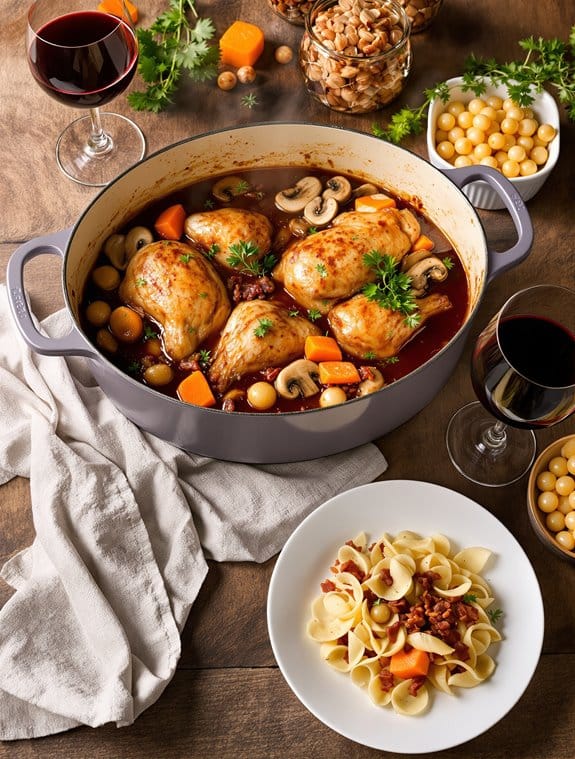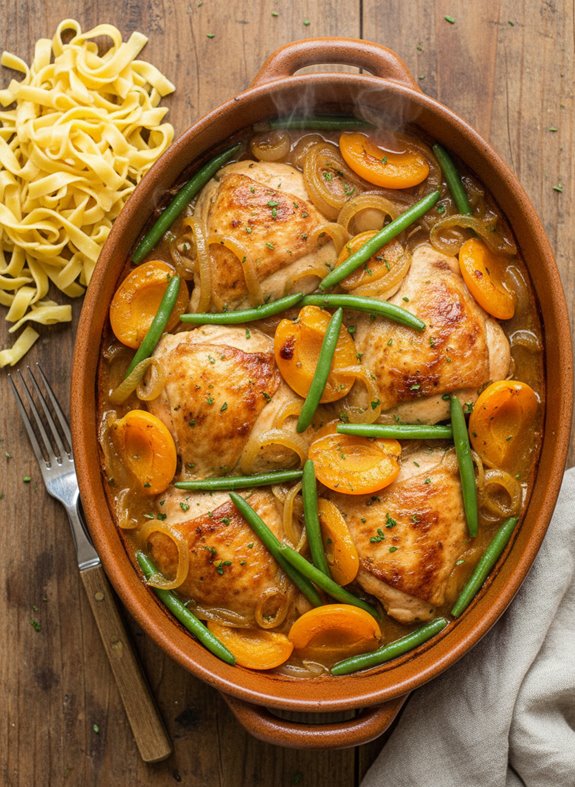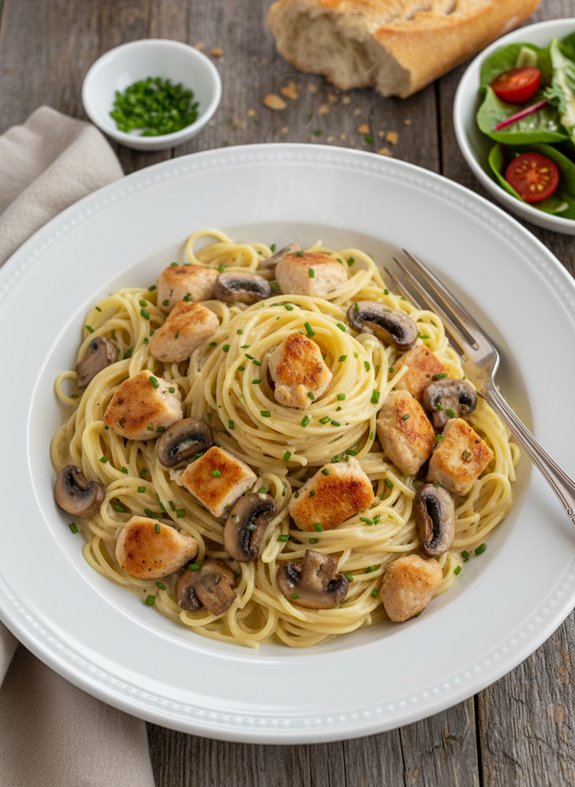Why You’ll Love this Coq au Vin
If you’ve ever wanted to master a classic French dish without flying to Paris, this Coq au Vin is your ticket to culinary bliss.
I’m obsessed with how this chicken-wine masterpiece transforms humble ingredients into something spectacular.
The magic happens when bacon meets burgundy, creating a sauce so rich you’ll want to drink it with a straw.
Trust me, there’s something deeply satisfying about watching chicken simmer in wine until it’s fall-off-the-bone tender.
The cognac flambe? Pure drama in your kitchen.
Your guests will think you trained at Le Cordon Bleu, not that I’m suggesting you lie.
What Ingredients are in Coq au Vin?
Coq au Vin might sound fancy, but its ingredients are surprisingly straightforward. This classic French dish combines humble kitchen staples to create something truly magnificent—tender chicken swimming in a rich wine sauce that tastes like it took days to develop.
The beauty lies in how simple ingredients transform during a slow simmer, with the wine reducing to create complex flavors that seem almost magical.
- 4 slices bacon
- 2 chicken breasts
- 2 chicken thighs
- 2 chicken legs
- 1/2 cup flour
- Salt and pepper
- 2 cloves garlic, chopped
- 2 cups white pearl onions, peeled
- 2 cups small mushrooms (slice larger ones)
- 2 carrots, cut in 2-inch pieces
- 1/2 cup cognac or brandy
- 1 bottle Burgundy wine
- 2 cups chicken broth
- 5 sprigs fresh thyme
- 2 teaspoons herbes de provence
- 3 bay leaves
- Fresh parsley, chopped (for garnish)
When shopping for this recipe, quality matters but doesn’t need to break the bank. For the wine, any decent dry red will work—no need to splurge on an expensive bottle since it’s going to simmer away.
The cognac brings a lovely depth, but if you’re not comfortable with the flambé technique (which, honestly, can be a bit nerve-wracking the first time), you can skip it and still get delicious results.
Pearl onions can be a pain to peel, so look for frozen ones as a time-saver. And remember, this is peasant food at heart—it’s meant to be rustic and forgiving.
How to Make this Coq au Vin

To make this classic French dish, start by frying 4 slices of bacon in a large, heavy Dutch oven until they’re perfectly crisp. Once done, transfer the bacon to paper towels but—and this is essential—keep that luxurious bacon fat in the pan. It’s liquid gold for the next step.
Season your chicken pieces (2 breasts, 2 thighs, and 2 legs) with salt and pepper, then coat them in the 1/2 cup of flour before browning them in that hot bacon fat. Those crusty, browned bits are pure flavor, so don’t rush this step.
Now comes the aromatic symphony—add 2 cloves of chopped garlic, 2 cups of peeled pearl onions, 2 cups of mushrooms, and 2 carrots cut into 2-inch pieces.
Let them sauté for about 2 minutes until slightly softened. Here’s where things get exciting (and a little dramatic): remove the pan from heat, pour in 1/2 cup of cognac, return to the flame, and if you’re feeling adventurous, carefully light the fumes with a long match to flambé.
Don’t worry if this seems intimidating—keep the pot lid nearby just in case, and remember the flames will subside within a minute. The flambéing isn’t just for show; it adds incredible depth of flavor.
After the flames die down, gradually stir in one bottle of Burgundy wine and 2 cups of chicken broth.
Once everything’s well blended, add your herbs: 5 sprigs of fresh thyme, 2 teaspoons of herbes de Provence, and 3 bay leaves.
Cover and let it simmer for a full hour, allowing all those flavors to meld together. Then uncover and simmer for another 15 minutes to reduce and thicken the sauce.
For extra thickness, you might want to stir in a tablespoon of tomato paste. The final touch? Top with that reserved crumbled bacon and fresh chopped parsley before serving over noodles or rice.
What you’ll have is a deeply flavored, soul-warming dish that’s both impressive and comforting.
Coq au Vin Substitutions and Variations
While this classic recipe creates a magnificent dish, I’ve learned over years of cooking that Coq au Vin welcomes creativity and adaptation.
Don’t have cognac? Brandy works beautifully, or skip the flambé altogether. Red Burgundy is traditional, but any dry red wine—Pinot Noir or Merlot—will create that rich, velvety sauce we crave.
You can swap chicken parts based on preference, use turkey for a twist, or even try rabbit if you’re feeling adventurous.
Vegetarians in your life? Try using portobello mushrooms as the protein star.
Sometimes I add a splash of tomato paste instead of cornstarch, giving the sauce a deeper complexity.
What to Serve with Coq au Vin
When choosing perfect accompaniments for this hearty French classic, I’m always drawn to starches that soak up that magnificent wine sauce.
Buttered egg noodles are my go-to, their gentle curves capturing every drop of that rich burgundy goodness. Rice works beautifully too, especially a simple white pilaf.
For vegetables, think French-inspired simplicity. A crisp green salad with a light vinaigrette cuts through the richness, while steamed green beans or roasted Brussels sprouts provide earthy contrast.
Fresh crusty bread is non-negotiable in my house—how else would you mop up those last bits of sauce? Trust me, you won’t want to waste a drop.
Final Thoughts
Coq au Vin stands as one of France’s most beloved contributions to world cuisine, and I’ve found it’s worth every minute spent in the kitchen. The magic happens when humble ingredients transform through slow cooking into something extraordinary.
Remember, patience is key. Let the flavors meld while you sip the remaining wine (cook’s privilege). Don’t stress about perfection – this rustic dish has survived centuries without Instagram-worthy plating.
My grandmother always said cooking with wine builds character, in the food and the cook.
Whether for a romantic dinner or family gathering, this classic never disappoints. The symphony of bacon, wine, and herbs? Simply unforgettable.

Coq Au Vin
Ingredients
Equipment
Method
- In a large, heavy Dutch oven, fry the bacon until crisp. Transfer to paper towels but keep the bacon fat in the pan.
- Season chicken pieces with salt and pepper, then coat them in flour.
- Brown the chicken in the hot bacon fat until golden on all sides. Don’t rush this step as the browned bits add flavor.
- Add the chopped garlic, pearl onions, mushrooms, and carrot pieces. Sauté for about 2 minutes until slightly softened.
- Remove the pan from heat, pour in the cognac, then return to the flame. For the flambé technique, carefully light the fumes with a long match. Keep the pot lid nearby as a precaution. The flames will subside within a minute.
- After the flames die down, gradually stir in the Burgundy wine and chicken broth until well blended.
- Add the fresh thyme, herbes de Provence, and bay leaves.
- Cover and simmer for 60 minutes, allowing all the flavors to meld together.
- Uncover and continue simmering for another 15 minutes to reduce and thicken the sauce.
- Top with the reserved crumbled bacon and fresh chopped parsley before serving.



